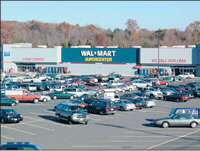Mullumbimby Action Group -> articles -> walmartandwoolies
Wal-Mart in Woolies clothing: the tactics of expansion by David Maslow
An article last month's Echo, (February 19) mentioned how Woolworths appears to be patterning its operating procedures on America’s infamous WalMart retail giant. I have just returned from spending many years in the US as a property analyst. My work included shopping centres that contained a WalMart, particularly in the southeast of the country. There, anti- union labour laws and few development controls have allowed WalMart to run rampant. Guy Rundle, quoted in last month’s arti- cle, accurately described the bleak landscape in South Carolina.
In conventional economic terms,Woolworths Limited, an independent company, is one of Australia’s,and share-holders’, great success stories. Woolworths is still primarily a supermarket, with 86% of its 2007 revenue coming from the supermarket division. But its growing reach into electronics, liquor, petrol, variety stores (Big W), plus the opening of new buying offices in India and China, suggest they may be viewing the market dominating tactics of Wal-Mart as a model. That trend makes sense, because Wal-Mart is the world’s largest and arguably most successful corporation. Four of the ten richest Americans are heirs of Sam Walton.Wal-Mart combines supermarket and general merchandise sales, including pharmacy, appliances, clothing, tyres and electronics under one roof.The typical store,without a food market, is just over two acres in size, but the latest model superstores that include food, cover over four acres. Wal-Mart’s success as the world’s number one retailer is based on high-tech inventory control,driving out competition, and scandalous labour practices,keeping costs to a minimum. In many small towns across America, they are often the only store left standing. In such instances they may become the only commercial employer in the town.Along this path to corporate Nirvana Wal-Mart is known for its union-busting, small town local retailing destruction and the poverty and despair that lie in its wake.
This is the situation I saw in the mid-1990s in Eastern Tennessee, a rural area between Chattanooga and Knoxville.The once charming commercial centre of Madisonville was completely boarded up. Except for a couple of law offices, not one retail store was open. A couple of kilometres away was a Wal-Mart, in a small centre that also contained a couple of fast food joints. A local realtor said that the housing market had dried up and people were leaving because there were no jobs that paid a living wage, other than a few government and service jobs. Sadder still was that the Wal-Mart was scheduled to close. A large superstore was nearing completion about 20km away and all of the smaller model Wal-Marts in the region were closing. That meant that the people served by the original Wal-Marts had to drive 15km to 50km or so to buy basic necessities as pretty much every other store had been wiped out by the original Wal-Mart.
Wal-Mart employees are offered barely subsistence wages. Healthcare benefits, if any, are so expensive that most employees can’t afford them, so they are forced to go on to Medicaid, the inadequate public health system of last resort for the poor. Any employee found talking to a union representative is summarily fired. Illegal immigrants, typically from Mexico, are prime targets for cleaning staff. They are offered extraordinarily low wages and forced to work long hours. Stories abound of mistreatment such as locking exit doors so they can’t leave during the night shift. Deaths have occurred from blocked fire escapes. Yes, Woolworths has a softer touch. It prides itself on employee relations… it loves the lower-wage 16 to 20 year-old group. It has even started a green store program and has an excellent food waste recycling program – maybe there is money in it. But its treatment of suppliers, demanding rock bottom prices, and its predatory pricing practices that drive out competition, all smack of Wal-Mart.
Last month’s article described the example of the destructive effects of a Woolworths enclave on Kempsey. The concentration of a Big W with the supermarket and liquor store in Kempsey suggest that a Woolworths megastore concept may be waiting to happen. Who needs small shops anyway? Woolworths’ net income in 2007 was up over 20% from 2006, even though its food sales revenue was up only 9%. This is due to its diversification into the more profitable categories, as well as its improvements in IT and transportation operations, which saved the company $7.2 billion in 2007… Wal-Mart again.
The Woolworths 2007 AGM report discusses how future expansion will include 15 to 25 new stores per year. So there is tremendous corporate pressure to meet that target. Small town Australia, like Mullumbimby, will be under siege. In NSW, all this is facilitated by the huge ally this kind of development has in the notorious Planning Minister, Frank Sartor, the antiplanner. As we experienced in Mullumbimby, local Council disapproval of the supermarket DA now owned by Woolworths was simply swept aside. This has got to stop now. It appears to be only the beginning of the Wal-Marting of Australia.
article courtesy of The Byron Shire Echo March 4, 2008 and David Maslow
| April 2025 | ||||||
|---|---|---|---|---|---|---|
| S | M | T | W | T | F | S |
| 1 | 2 | 3 | 4 | 5 | ||
| 6 | 7 | 8 | 9 | 10 | 11 | 12 |
| 13 | 14 | 15 | 16 | 17 | 18 | 19 |
| 20 | 21 | 22 | 23 | 24 | 25 | 26 |
| 27 | 28 | 29 | 30 | |||
No events for today
Add your event here


